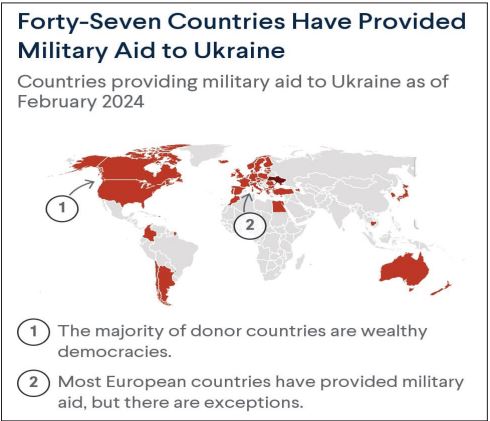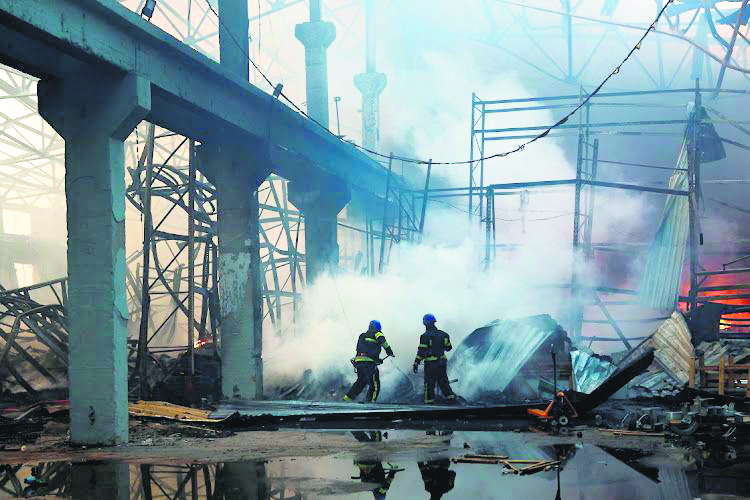Since Russia’s invasion in February 2022, Ukraine has become far and away the top recipient of U.S. foreign aid. This marks the first time that a European country has held the top spot since the Harry S. Truman administration directed vast sums into rebuilding the continent through the Marshall Plan after World War II.
When compared with the critical support to Ukraine from other countries and U.S. assistance to other top recipients of aid, the size and scale of U.S. aid to Ukraine stands out. However, some European governments, such as Norway, Lithuania, and Estonia, are making far larger financial contributions to Ukraine relative to the size of their own economies. Additionally, the magnitude of U.S. aid to Ukraine might seem less remarkable in comparison to what the Pentagon is budgeted each year, or what the Treasury was authorized to bail out Wall Street banks, auto companies, and other sectors of the economy during the U.S. financial crisis.



The extraordinary level of support the United States has provided Ukraine in its war against Russian invaders is apparent in the graphs provided here. As the two-year anniversary of Russia’s invasion of Ukraine approaches, additional aid for the latter country has stalled in the U.S. Congress after hardline Republicans expressed their opposition to further financial support for Ukraine’s war effort. President Joe Biden warned that the refusal to pass an aid package would be “playing into (Russian President Vladimir) Putin’s hands” and military analysts predicted that a halt to U.S. aid would hurt Ukraine’s prospects for winning the war.
But the U.S. is just one among many countries that have supported Ukraine since the start of the conflict in Eastern Europe. Global aid to Ukraine has reached a staggering 253 billion euros committed as of Jan. 15, or about $278 billion, according to the Kiel Institute for the World Economy. The group is trying to keep up with all of the commitments in its Ukraine Support Tracker, which keeps tabs on government-to-government transfers of military, financial and humanitarian aid into Ukraine.
The Germanybased institute also tracks allocations, which it defines as aid earmarked and/or specified for delivery in the near term. The majority of committed support by country has come from the United States, whose total aid commitment is valued at about $75 billion. The U.S. is followed by Germany and the United Kingdom for highest commitments overall. The European Union as a whole has committed approximately $93 billion in aid to Ukraine. The types of aid committed vary by country. The U.S. is flexing its military might, committing weapons and equipment valued at $46 billion – the most among countries and more than twice as much as Germany, which has promised the next-highest amount of military aid. Germany leads with the highest total amount of humanitarian aid among countries, followed by the U.S. and Switzerland.
While U.S. aid commitments and deliveries to Ukraine have essentially come to a halt given the political gridlock in Washington, European aid continues to grow, according to the institute. But whether that growth will be enough to support a winning war effort remains far from unclear. “Europe will have to at least double its current military support efforts in case there is no further support from the United States,” Christoph Trebesch, head of the Ukraine Support Tracker and the research director at the Kiel Institute, said in a statement. “This is a challenge, but ultimately a question of political will.”
The institute estimates the individual commitments of EU members by using each country’s contributions to the overall EU budget and shares in the European Investment Bank. Much of that European aid is financial rather than military. The Ukraine Support Tracker team noted in a news release that there is a “large gap between commitments and allocations” in Europe. As of Jan. 15, the EU and its member states have committed a total of about $155 billion in aid, but allocated just $83 billion of that total for specific purposes, according to the institute. While big, wealthy countries can afford to provide more in absolute terms, smaller countries are making significant offerings of their own.
In fact, relative to each country’s gross domestic product, the countries near Ukraine are providing the most support. Denmark and Estonia have each committed aid totaling more than 2% of their gross domestic product, with Estonia being the highest, at 3.55%, according to the tracker. Norway, Lithuania, Latvia, Finland and Poland also stand out among the highest donors by share of GDP. Malta, on the other hand, has committed aid totaling only 0.01% of its GDP, the lowest for European countries in the data.
The U.S. has committed 0.32% of its GDP toward Ukraine aid, which falls below the percentages committed by the U.K. (0.55%) and Germany (0.57%). Outside of the U.S. and Europe, other significant contributors include Japan, Canada and South Korea. The tracker doesn’t include private donations, or help from international organizations like the Red Cross, due to a “lack of comparable and reliable data,” according to the institute.
Will Ukraine Survive without the US aid
Russia’s war of aggression against Ukraine is about to enter its third year. There is much to feel good about, but there are also grounds for worry. In short, it is time to take stock. What Ukraine and its Western backers have accomplished in the wake of Russia’s February 2022 invasion is extraordinary. Russia, a nuclear-armed power with three and a half times the population of Ukraine, ten times the GDP, and a military with many times the personnel and equipment, has been fought to something close to a draw.
Ukraine controls some 80% of its territory, much as it did two years ago. Russian President Vladimir Putin obviously calculated that his war of conquest would resemble his previous invasion of Ukraine in 2014, when Russian forces swept in and quickly seized Crimea and much of the eastern Donbas region. He saw Ukraine, Europe, and the United States as weak and divided. He also believed his generals when they promised that Russia’s military was strong and would overwhelm whatever resistance Ukraine could muster.
All these assumptions have been proved wrong. But there is reason to be concerned nonetheless. Ukraine’s highly anticipated counter-offensive, designed to liberate territory and deliver a battlefield win or at least momentum that would set the stage for promising diplomacy, was largely rebuffed. Russia has learned to live with Western economic sanctions and has largely rerouted vital energy exports to China and India. Western military sanctions have likewise been evaded: Russia has continued to sell weapons to India and others and buy them from North Korea and Iran.
It has also been able to purchase ostensibly civilian technology and products that can be repurposed for military use. It has expanded its defense industrial base and now has a sizeable advantage over Ukraine in the quantity of artillery and ammunition that it can deliver to the battlefield. Russia shows few signs of exhaustion. Despite the extraordinary human toll of the war, estimated to be more than 300,000 Russian troops killed or injured, Putin’s control of the media and public narrative has allowed the Kremlin to minimize dissent and persuade many Russians that their country is the victim rather than an aggressor. Meanwhile, Ukraine is showing signs of political division.
Ukrainian President Volodymyr Zelensky just fired his top general. More important, Ukraine is struggling on the battlefield, largely owing to Republicans in the US Congress blocking a $60 billion military assistance package. Republican opposition appears to reflect a mixture of resurgent isolationism, sympathy for the authoritarianism of Putin, and a partisan desire not to hand President Joe Biden a political victory before the presidential election in November. Ideally, Biden will be able to convince enough Republicans to work with him and fellow Democrats to approve a new tranche of assistance, which is in America’s strategic interest.
But this outcome cannot be counted on, despite growing evidence that Ukraine is running short of arms and ammunition and, as a result, experiencing mounting difficulty in standing up to Russian military pressure. This raises the question: How might Ukraine and its friends in Europe and elsewhere fill at least some of the void left by a US no longer prepared to offer significant levels of assistance?
Europe has already agreed to provide Ukraine with more than $50 billion in new economic aid; together with others (such as South Korea and possibly Japan), a coordinated plan is also needed to provide Ukraine with arms and ammunition so it can better defend itself and strike important Russian military targets.
At the same time, Ukraine’s friends must help it reconstitute and expand its arms industry, so that it becomes less dependent on the ability and willingness of others to provide the resources the war effort requires. At the same time, Ukraine can reduce its resource needs and save lives by adopting a largely defensive military strategy. Protecting and preserving the 80% of the country Ukraine now controls is feasible and essential. Ukraine would not be giving up anything by embracing such a posture, given that military liberation of Crimea, Donbas, and other Russianoccupied areas is not in the cards, at least in the short term. And it can continue to seek full territorial restitution at the negotiating table if and when serious talks commence.
If the provision of arms will determine how Ukraine fares this year, the US presidential and congressional elections in November will go a long way toward determining how it fares in 2025 and beyond. If Biden is re-elected, and if the US Senate flips to Republican control, as many expect, but the Democrats retake the House of Representatives, then the stage will be set for renewed US economic and military aid and possibly a tie between Ukraine and NATO.
This would disabuse Putin of the view that time is on his side, in turn increasing the odds that diplomacy would come to the fore. If, however, former President Donald Trump wins and the Republicans maintain control of the House of Representatives, Ukraine will face a far more difficult future. The burden of Ukraine’s security would fall even more on itself and its friends in Europe and Asia.
If they prove willing and able to fill much of the gap left by a withdrawal of US support, one could envision a prolonged stalemate on the battlefield followed by constructive diplomacy. If not, Putin would be likely to press his advantage on the battlefield and come to the negotiating table only to impose the outcome he has sought from the beginning. The difference between these two futures is stark.
The stakes for Ukraine, for Europe, and for the world are enormous. Chinese President Xi Jinping, with his own designs on Taiwan, is watching with keen interest how this plays out. So, too, is Iran. If the US proves unwilling to meet its obligations and uphold the rule of international law that territory may not be acquired by force, we are looking at a future far more violent and dangerous than the past.







